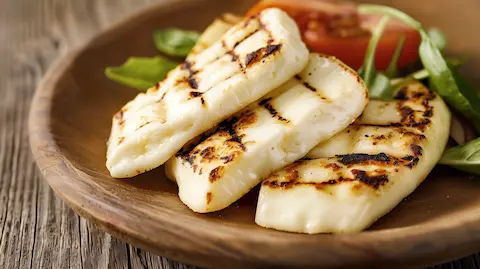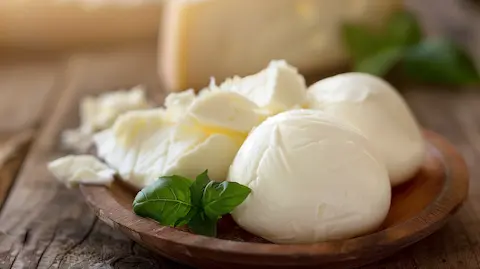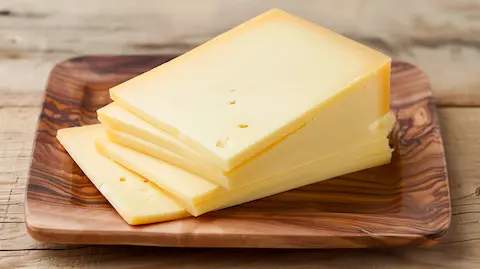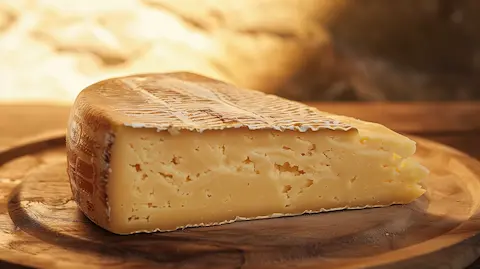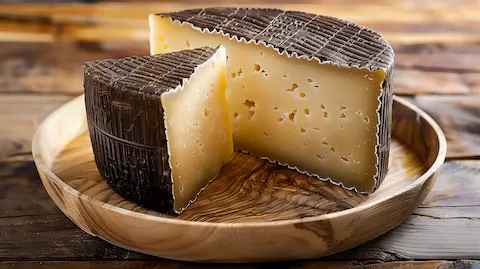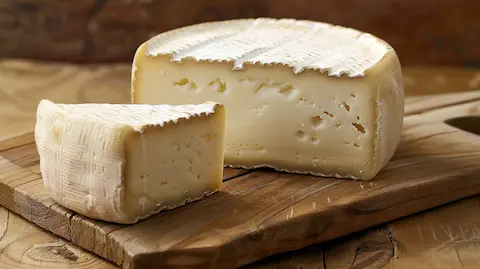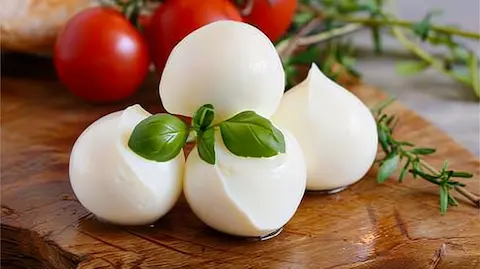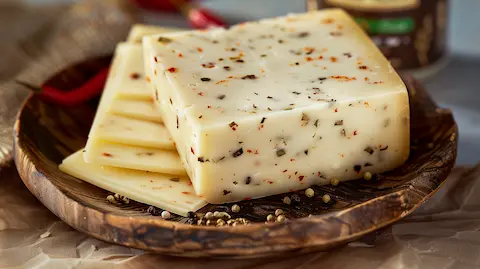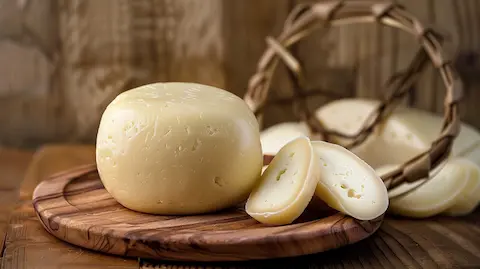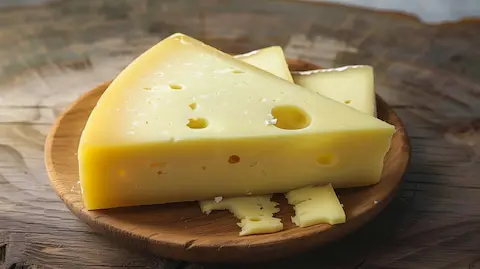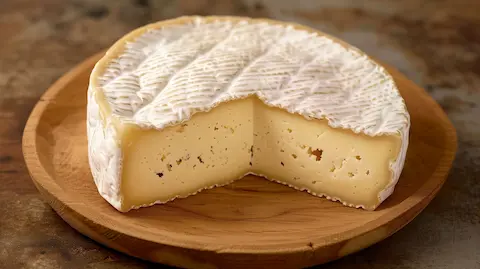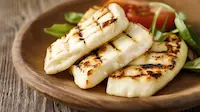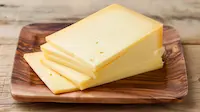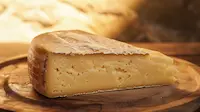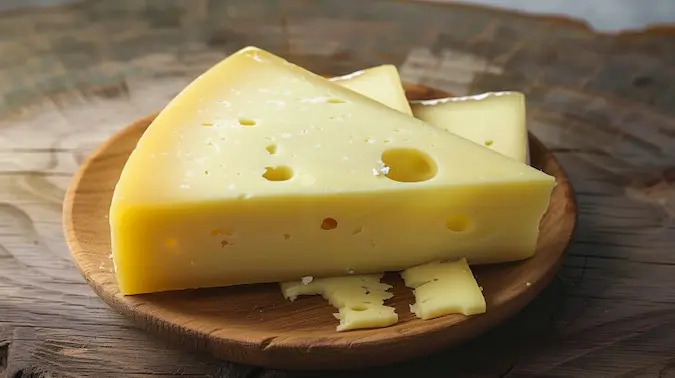Jarlsberg Cheese
Renowned for its mild, nutty flavor and distinctive large holes, Jarlsberg is a semi-soft cheese that originates from Norway. A derivative of Swiss Emmental, it has become a beloved staple in households and culinary settings worldwide. Jarlsberg's smooth, rubbery texture makes it a versatile choice for both cooking and snacking.
Next, we explore how Jarlsberg cheese is crafted, revealing the secrets behind its unique characteristics.
How is Jarlsberg made?
Jarlsberg cheese is made using traditional Norwegian methods, combining pasteurized cow's milk with a proprietary blend of bacteria. The milk is first warmed and then inoculated with the cultures, which include Lactococcus lactis and Leuconostoc mesenteroides. Rennet is added to coagulate the milk, forming curds. These curds are then cut, stirred, and partially cooked, allowing whey to be released. After whey drainage, the curd is pressed into molds and brined to enhance flavor and preservation. The cheese is then matured in temperature-controlled rooms, where it develops its characteristic holes and flavor profile over a period of several weeks to months.
Here is a detailed table outlining the production process of Jarlsberg cheese:
Jarlsberg Cheese Production Process
| Step | Ingredient(s) | Method | Temperature | Duration |
|---|---|---|---|---|
| 1. Pasteurization | Cow's milk | Heat treatment | 72°C (161°F) | 15 seconds |
| 2. Inoculation | Lactococcus lactis, Leuconostoc mesenteroides | Addition of cultures to milk | 32°C (90°F) | 30 minutes |
| 3. Coagulation | Rennet | Addition to milk, forming curds | 45 minutes | |
| 4. Curd Processing | Cutting, stirring, and partial cooking of curds | 39°C (102°F) | Varies | |
| 5. Whey Drainage | Separation from curds | Varies | ||
| 6. Pressing | Curds placed in molds and pressed | Varies | ||
| 7. Brining | Salt | Immersion of cheese molds in brine | 24 hours | |
| 8. Maturation | Aging in temperature-controlled rooms | 10-15°C (50-59°F) | Several weeks to months |
Jarlsberg cheese profile
Understanding the profile of jarlsberg cheese involves more than just taste; it encompasses a range of characteristics that define its identity. Below is a list of key facts about Jarlsberg cheese:
- Made from: Pasteurized cow's milk
- Country of origin: Norway
- Region: Primarily produced in the county of Viken
- Family: Swiss cheese
- Type: Semi-soft
- Texture: Smooth, rubbery, with large holes
- Rind: Wax-coated, typically tan to brown
- Colour: Pale yellow
- Flavour: Mild, nutty, and slightly sweet
- Aroma: Subtle, with hints of nuts and butter
- Vegetarian: No, due to the use of animal rennet
- Producers: Various, including Tine SA, the largest producer
Origin: Where does Jarlsberg cheese come from?
Jarlsberg cheese comes from Norway, where it was first developed in the 1950s by researchers at the Agricultural University of Norway. Its production was inspired by traditional Swiss cheesemaking techniques, yet it has developed a distinct identity and reputation that is recognized internationally.
How to store Jarlsberg?
Proper storage of Jarlsberg is vital for maintaining its quality and extending its shelf life. Jarlsberg should be kept refrigerated at all times. Wrap the cheese in wax paper or cheese paper, which allows it to breathe while maintaining optimal humidity. Avoid using plastic wrap as it can cause the cheese to sweat and promote bacterial growth. If the original packaging is resealable, it can be used to store the cheese after opening.
- Initial Storage: Keep in the refrigerator, ideally in the vegetable drawer where the temperature is consistent.
- Wrapping: Use wax or cheese paper for wrapping, then place in a loose-fitting plastic bag to maintain humidity.
- Refrigeration: Store at 4°C (39°F) to ensure the cheese remains fresh.
- Handling: Minimize handling and exposure to air to prevent contamination and drying out.
How long does Jarlsberg cheese last?
Jarlsberg cheese's shelf life depends on its storage conditions. When stored properly in the refrigerator, an unopened package of Jarlsberg can last up to 2-3 months. Once opened, it should be consumed within 3-4 weeks to enjoy its best quality. Freezing is not recommended, as it can alter the texture and taste of the cheese. However, if you must freeze Jarlsberg, it can be stored for up to 6 months. When thawed, the cheese may become crumbly and lose some of its mild, nutty flavor.
| Storage Location | Unopened | Opened | Frozen | Texture After Thawing | Taste After Thawing |
|---|---|---|---|---|---|
| Fridge | 2-3 months | 3-4 weeks | |||
| Freezer | Up to 6 months | Crumbly | Mild flavor loss |
Can you freeze Jarlsberg?
Yes, you can freeze Jarlsberg. Freezing may extend its shelf life up to 6 months. However, be aware that freezing can change the texture, making it more crumbly, and may slightly diminish its mild, nutty flavor once thawed.
Alternatives to Jarlsberg cheese
For those seeking variety or a substitute for Jarlsberg due to availability or dietary preferences, there are several cheeses that offer similar textures and flavors. The following table provides a comprehensive look at alternatives that can complement your dishes in a manner akin to Jarlsberg.
Jarlsberg Cheese Substitutes
| Cheese | Origin | Milk Source | Texture | Flavor | Best Used In |
|---|---|---|---|---|---|
| Emmental | Switzerland | Cow's milk | Firm, with large holes | Nutty, sweet | Sandwiches, Fondue |
| Gruyère | Switzerland | Cow's milk | Dense, creamy | Savory, slightly sweet | Quiche, Gratins |
| Swiss cheese | United States | Cow's milk | Semi-soft, with medium holes | Mild, nutty | Burgers, Sandwiches |
| Maasdam | Netherlands | Cow's milk | Semi-soft, with large holes | Sweet, nutty | Snacking, Salads |
| Edam | Netherlands | Cow's milk | Semi-hard | Mild, slightly salty | Snacking, Melting |
| Fontina | Italy | Cow's milk | Semi-soft | Rich, earthy | Pizza, Risotto |
How to use Jarlsberg
Jarlsberg's versatility in the kitchen is one of its most celebrated qualities. For slicing, a cheese plane or thin-bladed knife works best, especially when aiming for even, delicate pieces that are ideal for sandwiches or cheese platters. When cutting into wedges for a cheese board, a sharper knife is preferred to handle its semi-soft texture. Jarlsberg is excellent for melting, making it a prime candidate for grilled cheese sandwiches, cheesy pasta dishes, and pizza toppings. It also adds a delightful twist to omelets and quiches, and its nutty flavor enhances the taste of baked goods.
- Sandwiches and burgers: Thinly sliced for cold sandwiches or melted on burgers
- Cheese boards: Wedges paired with fruits, nuts, and cold cuts
- Grilled cheese: Melted between slices of crusty bread
- Pasta and pizzas: Grated or sliced for a gooey topping
- Salads: Shaved over greens for a rich, nutty accent
- Breakfast dishes: Incorporated into omelets and quiches
- Baking: Integrated into breads and pastries for a savory note
Recipes using Jarlsberg
Integrating Jarlsberg into recipes highlights its mild, nutty flavor and excellent melting properties. Here are some popular recipes that are a good fit:
- Cheese Omelette: Jarlsberg's meltability makes it perfect for a fluffy, savory omelette.
- Grilled Cheese Sandwich: The cheese melts uniformly, creating a gooey and delicious sandwich.
- Quiche Lorraine: Adds a nutty depth to the classic egg custard filling.
- Stuffed Mushrooms: When grated, Jarlsberg provides a rich, melty stuffing for appetizers.
- Caesar Salad: Shaved Jarlsberg offers a twist on the traditional Parmesan topping.
- Cheesy Garlic Bread: Sprinkled on top, it browns beautifully and adds complexity to the flavor.
- Macaroni and Cheese: Creates a creamy, indulgent dish with a distinctive Jarlsberg taste.
Jarlsberg nutrition data
There are 357 calories in Jarlsberg cheese per 100g. To understand its nutritional value, here's a concise table:
| Nutrient | Amount per 100g | % Daily Value* |
|---|---|---|
| Calories | 357 | |
| Total Fat | 27g | 42% |
| Saturated Fat | 17g | 85% |
| Cholesterol | 100mg | 33% |
| Sodium | 700mg | 29% |
| Total Carbohydrates | 0g | 0% |
| Dietary Fiber | 0g | 0% |
| Sugars | 0g | 0% |
| Protein | 27g | 54% |
| Calcium | 970mg | 97% |
| Iron | 0mg | 0% |
*Percent Daily Values are based on a 2,000 calorie diet. Your daily values may be higher or lower depending on your calorie needs.
What's next? WhatCheese insights
As the founder of WhatCheese, I've seen the cheese industry evolve and adapt, and Jarlsberg has consistently held a place at the table. For enthusiasts looking to purchase this versatile cheese, specialty cheese shops and well-stocked supermarkets often carry Jarlsberg. However, for a truly immersive experience, I recommend visiting renowned vineyards that offer cheese tastings. These venues often pair Jarlsberg with wines that highlight its nutty and sweet undertones, providing an enriching sensory experience.
Moreover, cheese festivals and events are fantastic opportunities to explore Jarlsberg in the context of the broader cheese community. These events often feature tastings, workshops, and the chance to meet cheesemongers who are passionate about their craft. Below is a table of recurring events where Jarlsberg and other fine cheeses take center stage.
For those who are unable to travel, there are numerous online retailers that stock Jarlsberg, making it accessible to cheese lovers everywhere. Always look for the authentic Jarlsberg label to ensure you're getting the genuine article.

